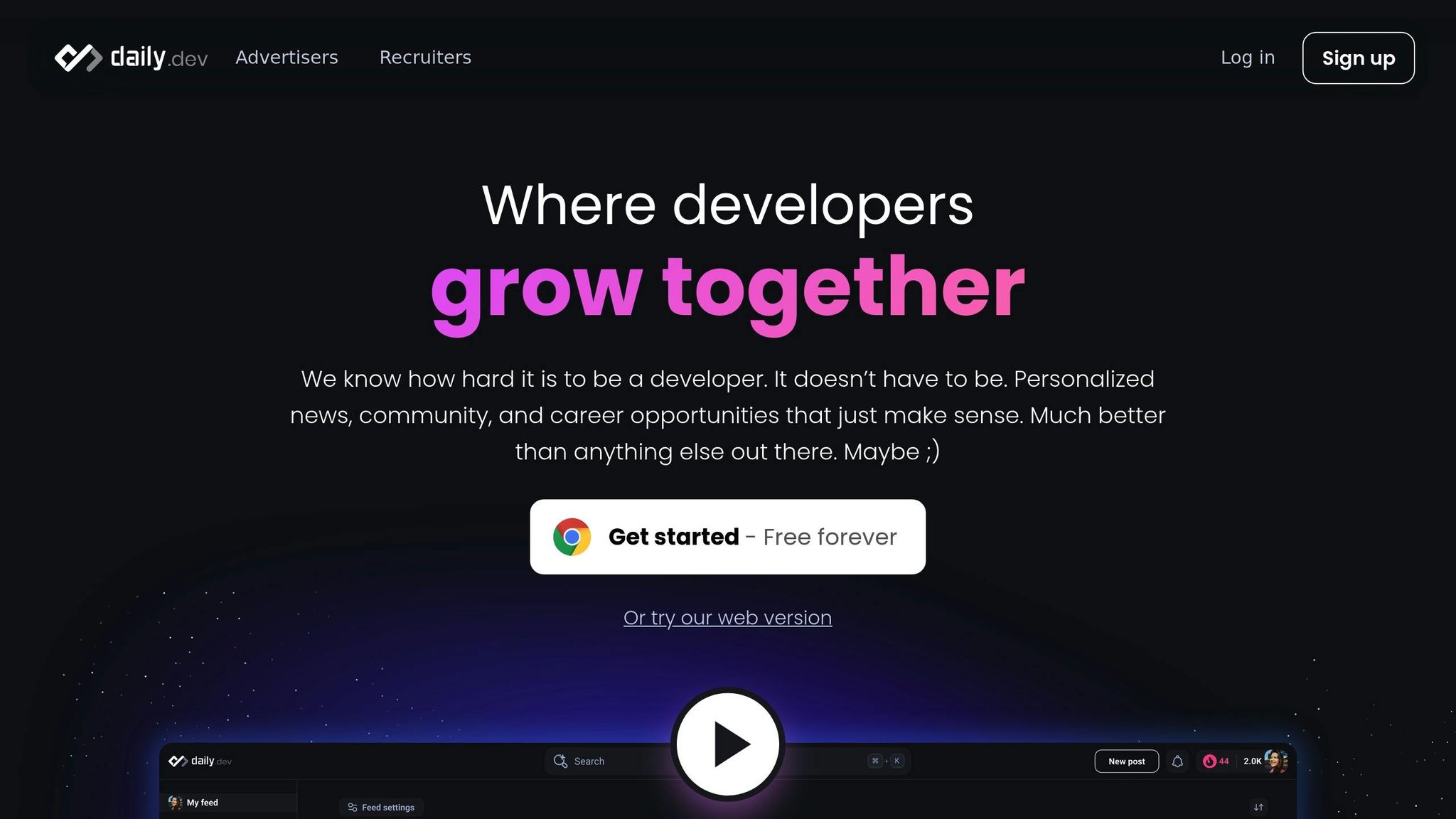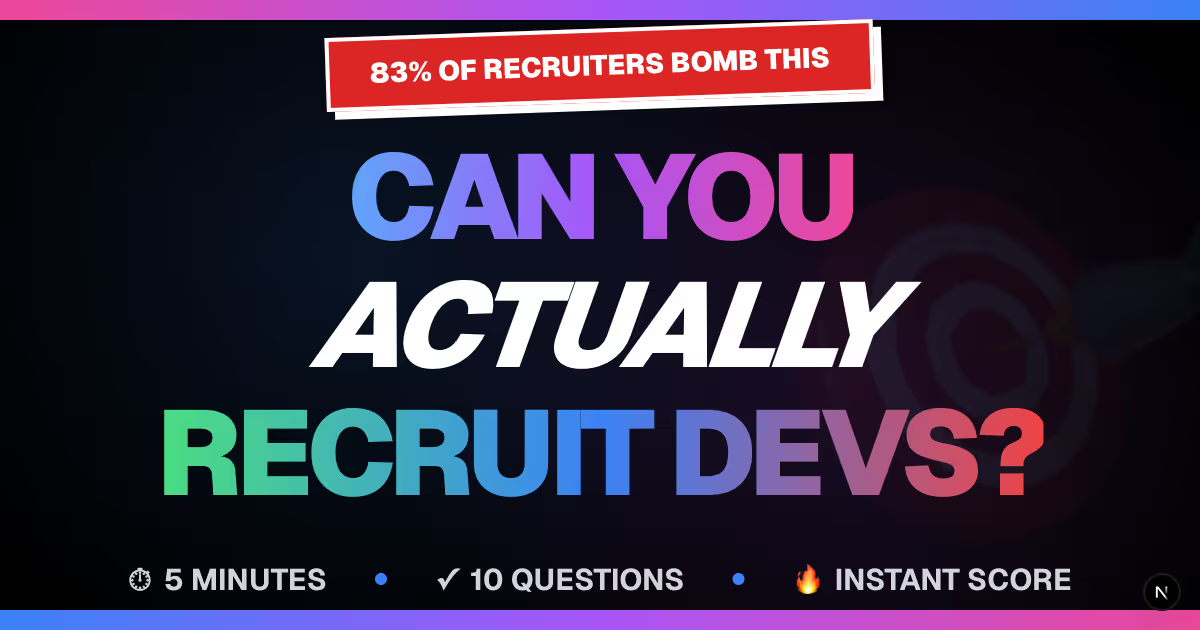


Recruiting developers has evolved; trust-based platforms and personalized engagement now drive successful hiring strategies.
In 2025, recruiting developers has shifted dramatically. Traditional methods like cold outreach and generic job boards are no longer effective. Developers now prefer trust-based platforms like daily.dev, which prioritizes meaningful connections and professional growth. With over 1 billion sessions and 1,000,000 developers, daily.dev shows that 90% of developers ignore outreach outside trusted networks, while double opt-in introductions achieve response rates of 85–90%.
Key takeaways for recruiters:
- Stop cold outreach: Use platforms that developers trust for better engagement.
- Prioritize relevance: Tailor job opportunities to align with developers' skills and goals.
- Focus on transparency: Share detailed role descriptions upfront, including salary and team dynamics.
- Leverage data: Use platform insights to target highly skilled, passive talent - 40% of daily.dev users are senior contributors or leaders.
This shift emphasizes trust, clear communication, and developer-first practices to connect with top technical talent.
New Trends in Developer Networks
The world of developer networks is undergoing a transformation, driven by the need for meaningful engagement and specialized spaces for technical professionals. Developers are gravitating toward environments that cater specifically to their professional growth and interests. For recruiters, staying on top of these trends is key to connecting with top-tier technical talent in ways that prioritize trust and genuine interaction.
Growth of Developer-Focused Platforms
Platforms tailored for developers are on the rise, offering spaces that cater directly to their unique needs. These platforms provide highly relevant technical insights that align with developers’ daily challenges and workflows. By focusing on this technical relevance, they foster deeper engagement and build strong community connections. It's not just about sharing knowledge - it’s about creating a space where continuous learning and professional growth thrive.
Hybrid Engagement Models and Developer Experience
Modern developer networks are moving toward hybrid engagement models, blending different types of interactions to create richer, more dynamic user experiences. Developers increasingly value platforms that offer personalized, interactive content that evolves alongside their careers. As daily.dev aptly describes:
"Personalized news, community, and career opportunities that just make sense." - daily.dev
These platforms seamlessly integrate career opportunities into their learning and community features, making it easy for developers to participate in discussions, expand their knowledge, and stay visible to potential employers - all without disrupting their experience.
AI and Continuous Learning in Developer Communities
Artificial intelligence is playing a pivotal role in transforming how developers learn and share knowledge. AI-powered tools enable more efficient and personalized learning experiences, a critical factor given the growing demand for roles like AI Engineer, Machine Learning Engineer, and Deep Learning Engineer. Developer networks are responding by offering specialized content and forums that focus on these cutting-edge fields.
As highlighted by a daily.dev Recruiter:
"Developers come to daily.dev every day to stay sharp on tools, technologies, and trends." - daily.dev Recruiter
Staying up-to-date is crucial in the fast-paced tech world, and these platforms are stepping up to provide timely resources and updates. For recruiters, tapping into AI-driven learning trends offers a unique opportunity to identify candidates who are proactive about enhancing their skills - often some of the most driven and capable professionals in the field.
How Network Trends Impact Recruitment
As developer networks evolve, they're transforming how recruiters connect with technical talent. These changes are reshaping recruitment strategies, making the old methods of mass outreach and generic messaging increasingly ineffective. Developers now gravitate toward platforms that value their time and expertise, pushing recruiters to rethink their approach.
From Cold Outreach to Trust-Based Interactions
The days of cold outreach are fading, replaced by trust-based, double opt-in interactions. This shift stems from developers' growing dissatisfaction with traditional recruitment methods.
The results speak for themselves: double opt-in interactions deliver significantly higher response rates. Developers who typically ignore generic messages are more likely to engage when approached through trusted networks. This highlights the power of trust in improving recruitment outcomes.
In the double opt-in model, every interaction begins with mutual interest. Developers review opportunities before agreeing to connect, ensuring that recruiters only engage with candidates who are genuinely interested. This approach minimizes mismatched expectations and eliminates unwanted contact, creating a more efficient process for everyone involved.
What Developers Want
To succeed in recruiting developers, understanding their preferences is key. Research shows that developers have distinct expectations compared to other professionals.
Privacy and discretion are top priorities. Developers want opportunities shared privately and only with those who truly fit their profile. This allows them to explore options without publicly signaling their job search.
Relevance is another critical factor. Developers expect job opportunities to align closely with their skills, interests, and career goals. Generic job blasts that overlook their expertise not only fail to connect but can also harm a recruiter’s credibility.
Developers also value control over the hiring process. They prefer to review role details upfront and decide whether to engage, rather than being pursued by recruiters. Transparency is equally important - developers want clear information from the start, including technical requirements, team dynamics, and growth opportunities. Vague job descriptions waste time and erode trust.
daily.dev has highlighted some common frustrations that developers face during the hiring process:
"We asked developers what's broken in hiring. Their answers: trivia interviews, ghosting, vague roles, fake jobs, and AI noise. Here's how to fix it (for real)." - daily.dev
Addressing these pain points is essential for building effective recruitment strategies that resonate with developers.
Using Metrics to Guide Recruitment Strategies
Data is now the backbone of modern recruitment strategies. Developer networks provide unparalleled insights into candidate behavior and preferences, enabling recruiters to refine their approach while maintaining the trust-based interactions that developers prefer.
Metrics like engagement rates and candidate quality offer real-time feedback, helping recruiters fine-tune their outreach efforts. For example, daily.dev’s network includes a high concentration of experienced talent - 40% are senior individual contributors and leaders. This targeted audience allows recruiters to achieve better results with fewer outreach efforts.
Platform engagement data also reveals where developers are most active. With over 1 billion developer sessions logged on daily.dev, recruiters can be confident their opportunities are reaching a highly engaged audience. This level of activity far surpasses what’s typically found on general professional networks.
Real-time tracking adds agility to recruitment strategies. Instead of waiting weeks to assess a campaign’s effectiveness, recruiters can monitor metrics daily and make adjustments on the fly - an essential capability in today’s competitive talent market.
Additionally, integrating these insights with existing ATS systems provides a more comprehensive view of candidates. Beyond traditional resumes, recruiters gain access to detailed profiles that include work history, current interests, and future goals. This enables more informed decisions about which opportunities to present and how to position them effectively.
Metrics-driven insights are reshaping recruitment, helping recruiters stay ahead in the race for top developer talent.
How to Adjust Recruitment Strategies for Developer Networks
Recruiting developers through specialized platforms requires a fresh approach. Success hinges on forming authentic connections, communicating clearly, and using platforms tailored for developers' unique preferences and needs.
Building Trust in Developer-Focused Platforms
Trust is the cornerstone of effective recruitment in developer communities. Unlike traditional job boards, where mass outreach might work, developer networks reward genuine interaction and credibility.
To build trust, start by actively participating in discussions on these platforms. Share valuable insights on industry trends, engage thoughtfully with technical posts, and contribute resources that developers find meaningful. This kind of involvement shows you’re more than just a recruiter - you’re someone who understands their world.
Consistency is key. Developers are more likely to trust someone who engages regularly and meaningfully rather than someone who only appears when there’s a role to fill. Over time, your ongoing presence can establish you as a reliable and knowledgeable figure within the community.
Transparency also plays a big role in trust-building. When discussing job opportunities, be upfront about critical details like salary ranges, team dynamics, and potential challenges of the role. Developers value honesty and clear expectations - they want to know exactly what they’re signing up for.
Finally, respect developers’ boundaries. If someone isn’t currently looking for a job, don’t push. Instead, focus on providing value, such as sharing industry insights or helpful resources. This approach keeps the relationship open for future opportunities while showing that you respect their current position.
Writing Developer-Friendly Job Descriptions
Traditional job descriptions often fall flat with developers because they prioritize company needs over what matters to technical talent. To attract developers, you need to take a different approach.
Start by highlighting the impact and technical challenges of the role. Developers want to know how their work will make a difference and what interesting problems they’ll tackle. Be specific about how the role contributes to the product or organization.
Provide enough context upfront to help developers decide if the role aligns with their goals. Include details about the tech stack, team size, development methodologies, and the product’s growth stage. This saves time by reducing mismatches between candidates and roles.
Clarity is crucial - be explicit about technical requirements and expectations. Vague job descriptions are a major frustration for developers. If the role involves maintaining legacy code or learning new technologies, mention it as part of the growth potential.
Structure your job postings as developer-focused briefs. Highlight the problems they’ll solve, the tools they’ll use, and the impact they’ll create. This transforms a standard job description into an appealing opportunity that speaks directly to developers’ interests.
To streamline the process, use custom screening questions for details that don’t fit into the main description. This keeps the job brief concise and engaging while still gathering the information you need for effective evaluations.
Clear, well-targeted job descriptions are a game changer for engaging developers on specialized platforms.
daily.dev Recruiter: A Developer-First Hiring Platform

Applying these strategies on a developer-specific platform like daily.dev Recruiter can deliver outstanding results. This platform reimagines how recruiters connect with technical talent, offering a smoother and more effective process.
daily.dev Recruiter is built on a thriving network of software engineers, eliminating the inefficiencies of traditional recruitment. It uses a double opt-in model, meaning developers review opportunities and choose to engage, ensuring recruiters connect only with genuinely interested candidates. This removes the spam-like experience often associated with other platforms.
The platform also provides access to pre-qualified developers who are actively participating in professional discussions and staying updated on industry trends. These developers are not only technically skilled but also open to exploring new career opportunities.
daily.dev Recruiter’s developer-friendly job brief format ensures roles are presented with all the context developers need - covering skills, interests, and career goals. This transparency helps developers quickly assess whether a role aligns with their expectations.
Additionally, the platform integrates seamlessly with existing ATS and sourcing tools, allowing recruiters to maintain their workflows while accessing higher-quality talent. Its clear pricing model eliminates surprises, enabling recruiters to plan budgets effectively while tapping into a global pool of engaged developers.
sbb-itb-d1e6221
Old Recruitment Methods vs. Developer-First Platforms
The way companies recruit technical talent has undergone a significant transformation. Traditional recruitment methods, which often work for general hiring, tend to fall short when it comes to engaging developers. These outdated approaches frequently result in poor response rates and mismatched candidates, leaving both recruiters and developers frustrated. In contrast, developer-first platforms have emerged as a solution, creating spaces where developers willingly participate in recruitment conversations.
Traditional methods rely heavily on cold outreach, mass job board postings, and static databases. Recruiters spend countless hours sifting through profiles, sending unsolicited messages, and screening candidates who may not even be interested in the role. This impersonal approach often feels intrusive, eroding trust before any meaningful dialogue can take place.
On the other hand, developer-first platforms like daily.dev Recruiter are flipping the script. These platforms boast impressive metrics, such as 85–90% reply rates for double opt-in introductions and access to 90% passive talent, including 40% senior-level contributors.
Comparison Table: Old Methods vs. Developer-First Platforms
| Aspect | Traditional Methods | Developer-First Platforms |
|---|---|---|
| Engagement Model | Cold outreach, unsolicited messages, and mass job board applications | Warm, double opt-in introductions from developers who choose to engage |
| Response Rates | Typically under 20% | 85–90% reply rates for qualified introductions |
| Candidate Quality | Requires extensive screening after initial contact | Pre-qualified matches based on skills, interests, and career goals |
| Developer Experience | Impersonal, often spam-like interactions | Personalized opportunities with full context and control over engagement |
| Recruiter Effort | High manual effort for sourcing and screening | Minimal outreach effort, with warm introductions delivered directly |
| Talent Pool | Primarily active job seekers and cold outreach responses | Access to 90% passive talent, including 40% senior contributors and leaders |
| Data Source | Static profiles and outdated databases | Active engagement data reflecting current interests and aspirations |
| Trust Factor | Often erodes trust through unsolicited contact | Builds trust through daily engagement and developer-first practices |
This side-by-side comparison highlights how developer-first platforms are changing the game. By focusing on trust and engagement, they provide a more effective and respectful way to connect with technical talent.
Instead of interrupting developers' workflows, these platforms prioritize their experience, offering personalized opportunities and meaningful interactions. This shift not only improves outcomes for recruiters but also creates a collaborative environment where developers feel valued, ultimately redefining the recruiting process for the better.
Conclusion: Matching Recruitment with Developer Network Trends
The way companies recruit technical talent has undergone a major transformation. Data from daily.dev reveals over 1 billion developer sessions and reply rates exceeding 85–90% for double opt-in introductions. Interestingly, 90% of developers on daily.dev disregard outreach that comes from outside their trusted network, and 40% of the platform’s users are senior contributors or engineering leaders. These figures highlight the importance of adapting recruitment strategies to align with how developers prefer to engage.
Key Points for Recruiters
To succeed in this evolving landscape, recruiters should:
- Prioritize warm introductions over cold outreach. Double opt-in introductions - where developers have already shown interest in the opportunity - respect candidates' time and yield better results.
- Adopt developer-friendly communication. Job descriptions and outreach messages should clearly explain the role, team dynamics, and technical challenges, offering transparency and relevance.
- Engage through trusted platforms. Developers are more likely to respond when approached within communities they trust, fostering more genuine and productive conversations.
- Target with precision. Tailor outreach to align with each developer’s skills, interests, and career aspirations. This approach moves away from mass outreach and focuses on meaningful, high-quality connections.
FAQs
How can recruiters build trust and effectively engage with developers using platforms like daily.dev?
Recruiters can build stronger relationships with developers by leveraging daily.dev Recruiter, a platform tailored to connect with developers in the spaces they naturally frequent. By emphasizing trust and relevance, daily.dev offers a warm, double opt-in process, ensuring that both recruiters and developers are genuinely interested in establishing a connection.
This method eliminates the need for cold outreach, focusing instead on personalized, meaningful interactions. It helps recruiters engage with skilled, active developers who are open to exploring the right opportunities. The result? A smarter, more streamlined way to connect talent with roles that truly fit.
How can recruiters better match job opportunities to developers' skills and career goals?
Recruiters aiming to match job opportunities with developers' skills and career goals should start with clear, detailed job descriptions. These descriptions should highlight the role's responsibilities, the skills required, and any potential for growth. When candidates are evaluated against well-defined criteria, it not only improves the chances of finding the right fit but also saves time for everyone involved.
Beyond that, personalized and thoughtful introductions to pre-screened developers can make a huge difference. A warm, tailored approach builds trust, helps developers feel appreciated, and encourages meaningful interactions. By focusing on genuine connections and offering roles that align with candidates' interests, recruiters can significantly improve engagement and outcomes.
How are AI and continuous learning in developer communities shaping recruitment strategies?
AI and the concept of continuous learning are reshaping the way recruiters find and connect with developers, making hiring processes sharper and more focused. AI-powered developer communities offer valuable insights into a candidate's skills, interests, and activity patterns, allowing recruiters to pinpoint individuals who truly match their requirements.
Within these communities, continuous learning plays a key role in keeping developers current with the latest technologies, ensuring they remain skilled and ready to tackle new challenges. By using platforms designed specifically for developers, recruiters can engage with passive, pre-qualified candidates in a more authentic and trust-centered manner. This approach minimizes the need for cold outreach and creates a smoother, more efficient hiring process for everyone involved.
Related Blog Posts








